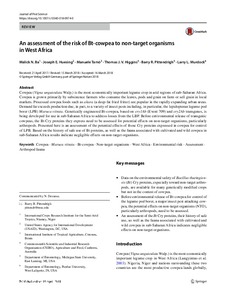| dc.contributor.author | Ba, Malick N. |
| dc.contributor.author | Huesing, J.E. |
| dc.contributor.author | Tamo, M. |
| dc.contributor.author | Higgins, T.J.V. |
| dc.contributor.author | Pittendrigh, B.R. |
| dc.contributor.author | Murdock, L.L. |
| dc.date.accessioned | 2019-12-04T11:19:13Z |
| dc.date.available | 2019-12-04T11:19:13Z |
| dc.date.issued | 2018-04-10 |
| dc.identifier.citation | Ba, M.N., Huesing, J.E., Tamò, M., Higgins, T.J., Pittendrigh, B.R. & Murdock, L.L. (2018). An assessment of the risk of Bt-cowpea to non-target organisms in West Africa. Journal of Pest Science, 1-15. |
| dc.identifier.issn | 1612-4758 |
| dc.identifier.uri | https://hdl.handle.net/20.500.12478/3422 |
| dc.description.abstract | Cowpea (Vigna unguiculata Walp.) is the most economically important legume crop in arid regions of sub-Saharan Africa. Cowpea is grown primarily by subsistence farmers who consume the leaves, pods and grain on farm or sell grain in local markets. Processed cowpea foods such as akara (a deep-fat fried fritter) are popular in the rapidly expanding urban areas. Demand far exceeds production due, in part, to a variety of insect pests including, in particular, the lepidopteran legume pod borer (LPB) Maruca vitrata. Genetically engineered Bt-cowpea, based on cry1Ab (Event 709) and cry2Ab transgenes, is being developed for use in sub-Saharan Africa to address losses from the LBP. Before environmental release of transgenic cowpeas, the Bt Cry proteins they express need to be assessed for potential effects on non-target organisms, particularly arthropods. Presented here is an assessment of the potential effects of those Cry proteins expressed in cowpea for control of LPB. Based on the history of safe use of Bt proteins, as well as the fauna associated with cultivated and wild cowpea in sub-Saharan Africa results indicate negligible effects on non-target organisms. |
| dc.format.extent | 1-15 |
| dc.language.iso | en |
| dc.subject | Cowpeas |
| dc.subject | Maruca Vitrata |
| dc.subject | Environmental Risk Assessment |
| dc.subject | Legume Pod Borer |
| dc.title | An assessment of the risk of Bt-cowpea to non-target organisms in west Africa |
| dc.type | Journal Article |
| dc.description.version | Peer Review |
| cg.contributor.crp | Grain Legumes |
| cg.contributor.affiliation | International Crops Research Institute for the Semi-Arid Tropics |
| cg.contributor.affiliation | United States Agency for International Development |
| cg.contributor.affiliation | International Institute of Tropical Agriculture |
| cg.contributor.affiliation | Commonwealth Scientific and Industrial Research Organisation |
| cg.contributor.affiliation | Michigan State University |
| cg.contributor.affiliation | Purdue University |
| cg.coverage.region | Africa |
| cg.coverage.region | West Africa |
| cg.coverage.country | Nigeria |
| cg.creator.identifier | Manuele Tamò: 0000-0002-5863-7421 |
| cg.researchtheme | PLANT PRODUCTION & HEALTH |
| cg.isijournal | ISI Journal |
| cg.authorship.types | CGIAR and advanced research institute |
| cg.iitasubject | Cowpea |
| cg.iitasubject | Grain Legumes |
| cg.iitasubject | Pests Of Plants |
| cg.iitasubject | Plant Health |
| cg.iitasubject | Plant Production |
| cg.journal | Journal of Pest Science |
| cg.howpublished | Formally Published |
| cg.accessibilitystatus | Limited Access |
| local.dspaceid | 95223 |
| cg.targetaudience | Scientists |
| cg.identifier.doi | https://doi.org/10.1007/s10340-018-0974-0 |

